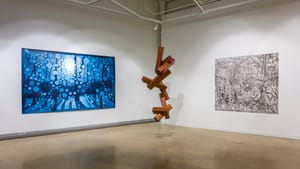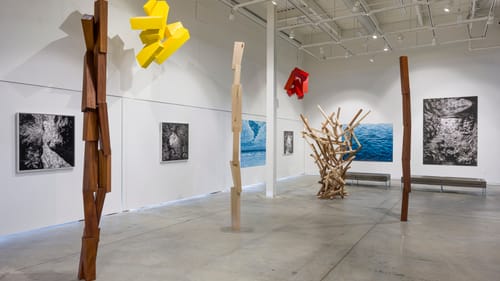Stay in the Loop
BSR publishes on a weekly schedule, with an email newsletter every Wednesday and Thursday morning. There’s no paywall, and subscribing is always free.
Illuminating nature
Drexel University’s Pearlstein Gallery presents A Certain Slant of Light

Emily Dickinson’s elegant phrase "a certain slant of light" is the title and unifying thread in an exhibition of sculpture by Orlando (Dino) Pelliccia, painting by Bruce Pollock, and photography by Stuart Rome. A Certain Slant of Light is now on view at the Leonard Pearlstein Gallery of Drexel University, where the artists were once faculty members.
Pelliccia: What do you see?
Light permeates Pelliccia’s crayon-bright wood constructions. It’s a homecoming for the one-time Pearlstein director, whose works advance from every direction. From the wall, a pyramid figure protrudes, and from above, tangles of twigs and two-by-fours dangle. On the floor stand piles of interconnected sticks, as though someone spilled canisters of Lincoln Logs, and spindly pieced-together towers balance end-on-end, steady but worrisome. At the far end of the gallery, a confederation of slats appear to be weaving themselves into a monumental basket.
The sculptures range from impressively large to bookshelf-sized. Pelliccia prefers to keep titles confidential, leaving viewers to interpret shapes for themselves. Is that deep amethyst stabile a bunch of grapes or a shark? Are the sunny yellow striplings shredded cheddar or a host of daffodils? You decide and, since none of the work on view is labeled, you can keep deciding.
Pelliccia’s sculpture, always minimalist, has recently shifted from figurative to spatial relationships, as Judith Stein writes in a forthcoming exhibition book: “Curious about ways to illustrate volume, [Pelliccia] began by building constructions of interlocking pieces of wood that ‘suggested they were confined in a box' …[He] balanced the components in precarious, interlocked, and jointed relationships.” And though perfectly still, the works increase their spatial presence by implying imminent motion, whether to sway, spin, or topple.
Pollock: Every kind of blue
In the Indigo series, Pollock translates nature into beautiful blue geometry. Pollock’s abstract canvases reveal the world as seen through a microscope. Representational paintings place viewers in snowy moonlit forests or on wave-lapped beaches, with fractals standing in for flakes and fog.
The incredible precision of Pollock’s work derives from fractal geometry, a relatively new branch of mathematics. “I know there’s mathematics in my work, but I never studied [advanced] math,” Pollock explained in describing his practice. “The geometry that I use comes from nature.” Simply, fractals are shapes that can be split into parts resembling the whole, resulting in visually complex patterns that occur in nature. Imagine a seashell’s internal chambers, dividing into ever-smaller identical shapes, drawing the eye inward, toward a center that keeps dividing.
There’s more than geometry at work, however. On Pollock’s palette, blue has endless potential. “When you use the most saturated pigment of indigo, it looks like black, but if you add the least bit of white to it, the blue comes out. It’s the deepest color I have found,” he said.
Black-blue features in a composition of pentagons, octagons, and their multilateral relatives converging and melting into a dark vortex. Another remarkable work is a lacework of triangles with almost-white endpoints, sparkling against an indigo background.

Pollock’s creative process begins with drawing, musing with pen on paper until he arrives at something worth enlarging. Next, he designs intricate grids to guide his painting. “I mimic the processes of nature,” Pollock says. “To me, the interplay of depth and surface is what’s really interesting in painting, like a window into an infinite space.”
Rome: A timeless text in the trees
In the Oculus photographs, Rome embodies the adage, "What you see depends on where you stand." To make the black-and-white images, he positions himself inside hollowed-out sequoia and redwood trees and waits to capture something divine.
Rome, who established Drexel’s photography program in the 1980s, has long sought to transcend time with his camera. In Latin America, he photographed pre-industrial culture and artifacts. In Haiti and Indonesia, he recorded practitioners seeking to enter other realms in trance rituals. For Rome, waiting for just the right light—that certain slant—in a tree, is merely another way of accessing eternity.
The trees serve as aperture and subject. At the optimal moment, Rome tilts his lens skyward to see not only the world beyond his perch but the trunk’s interior, a telescope through time. It takes study and patience to find the exact moment when rings and grain are perfectly lit, revealing like wrinkles on a face, connecting present to past. “These mammoth trees, some up to 5,000 years old, though hollow, remain alive … The longer I have looked at the natural world, the more I have imagined a hidden text within those patterns,” he has said.
How do we relate to nature?
A Certain Slant of Light clearly illustrates how Pelliccia, Pollock, and Rome relate to nature, but what of us? If we can’t sculpt trembling towers, or paint mathematically, and are too impatient to stand in hollow trees, can we nonetheless form deeper relationships with nature? Can we be more observant, think more expansively, and perceive connections through modern distractions? Can we see that we are not unlike a fractal, parts of a larger whole?
What, When, Where
A Certain Slant of Light. Through March 15, 2025, at Drexel University’s Leonard Pearlstein Gallery, URBN Annex, 3401 Filbert Street, Philadelphia. (215) 895-2548 or drexel.edu.
Accessibility
The Pearlstein Gallery is located on the first floor of the URBN Annex, which has a wheelchair-accessible entrance and restrooms. For more information, contact the gallery at (215) 895-2548 or Drexel University’s Office of Disability Resources at (215) 895-1401 or by email.
Sign up for our newsletter
All of the week's new articles, all in one place. Sign up for the free weekly BSR newsletters, and don't miss a conversation.
